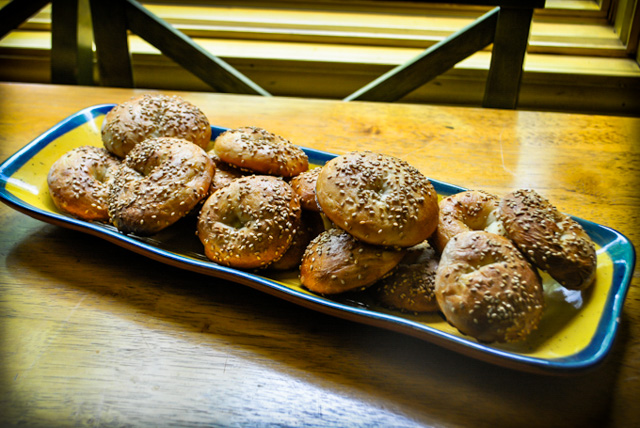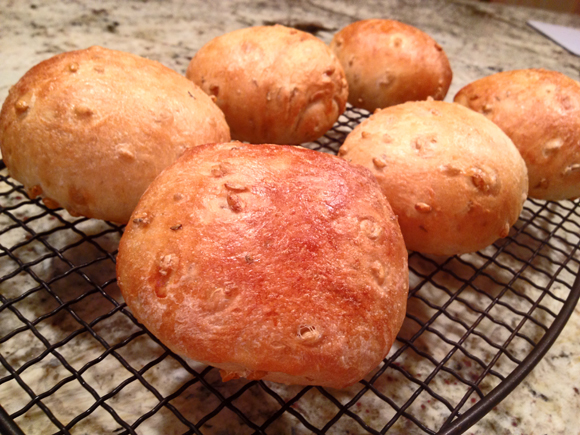Karen from Karen’s Kitchen Stories is a source of endless inspiration for me. Particularly on anything related to bread, she finds the most unusual, exotic, unique recipes, and then bakes them like it’s no big deal at all. Just to give you a recent example, look at this incredible concoction for which she used 12-ounce empty soda cans wrapped with foil as a baking “pan.” Amazing, isn’t it? Today I share with you my adventure with her Olive Oil Brioche. I made only half the recipe and still had a ton of dough to play with. Enough for a large loaf and 6 buns. For reasons that will be discussed in the comments, if you make it, be ready to have one loaf and 8 buns. The amount for the loaf pan was a tad too much.
OLIVE OIL BRIOCHE
(slightly modified from Karen’s Kitchen Stories)
for the poolish:
100 grams all purpose flour
100 grams water
1.5 grams instant yeast
Mix the ingredients, cover with plastic wrap, and place in the refrigerator over night.
for the levain (Sourdough)
1 tablespoon starter
110 grams all purpose flour
110 grams water
Mix the ingredients, cover with plastic wrap, and let sit overnight at room temperature until bubbly.
for the final dough:
200 grams poolish
150 grams levain
500 grams bread flour
12 grams salt
7.5 grams instant yeast
250 grams eggs
120 grams milk
80 grams honey
Zest of one Meyer lemon (optional)
25 grams water
220 grams extra virgin olive oil
For the egg wash: 1 egg plus one tablespoon milk
In a stand mixer, combine the flour, salt, yeast, eggs, milk, levain, poolish, honey, lemon zest, and water and mix on low for about 5 minutes. Cover and let rest for about 20 minutes.
Mix the dough with the spiral hook on medium to high speed for 8 minutes.
With the mixer running on medium, add the oil slowly, pausing so that the oil is absorbed. I did it in three additions. Incorporation of the oil will take time, so exercise patience. Add a sprinkle of bread flour to speed incorporation if you so desire, but do it only in the second and third addition. The dough should end up very smooth and not tear when you stretch it.
Allow the dough to bulk ferment (in a large bowl covered in plastic wrap) for 2 hours at 70 degrees F. Do three stretch and folds during the first 90 minutes, one every thirty minutes. When the dough is ready, remove three pieces of about 250g each and braid them. Place in a slightly oiled 9 x 5 loaf pan for final proofing. Divide the rest of the dough in 8 portions, shape as buns, and proof.
Heat the oven to 425 degrees F. After the bread has been proofing for 1 and a half to 2 hours (until doubled), brush with egg wash and bake until golden brown, 30 to 40 minutes, until internal temperature is 200 F. You can sprinkle sesame seeds on the buns if you so desire.
Un-mold the large loaf and cool on a wire rack together with the buns.
ENJOY!
to print the recipe, click here
Comments: I will not lie to you, this is a project. The bread requires a sourdough starter, a poolish (fermented flour using small amount of commercial yeast and prepared the day before), and commercial yeast in the final dough. But it is a total pleasure to work with, rises like a rocket and the texture and taste? You will not miss the butter, that’s for sure. As Karen said, it keeps a lot better than the traditional version. And freezes beautifully too.
When you start adding the olive oil, you will be sure the whole thing is ruined, and might have a few rude thoughts directed at me. It seems impossible for the dough to come together. Have bread faith. And here is a little tip that might help: as you add the olive oil and the mixer is going and going, with a puddle of oil all around and looking hopeless, add just a sprinkle of bread flour on top. It will help things get in shape faster. But just a sprinkle, I say 1 tablespoon or so. If you add the olive oil in three additions, do that in the final two, when the dough will have more trouble incorporating it.
For a 9 x 5 loaf pan, I advise you to make three strands with about 250g of dough in each. Then divide the rest in 8 buns. When you do that, you will be able to let the shaped loaf proof for closer to 2 hours and it will not rip a bit like mine did. I had no choice but to bake after 1 hour and 10 minutes, the dough wanted to leave the pan and explore the kitchen. No bueno. That’s because I used 300g per strand, a bit too much. Don’t be put off by the complexity of this recipe, once you have the starter and the poolish prepared the day before, it is just a matter of weighing all other ingredients and having some fun.
Karen, thank you for the inspiration, I know I tell you this all the time but it’s so true… Your blog is a pleasure to follow!
ONE YEAR AGO: Coconut and Lime Macarons
TWO YEAR AGO: Flank Steak Carnitas
THREE YEARS AGO: Sesame and Poppy Seed Sourdough
FOUR YEARS AGO: Pecan-Crusted Chicken from Southern at Heart
FIVE YEARS AGO: Lamb Shanks en Papillote with Cauliflower-Celeriac Purée
SIX YEARS AGO: Chestnut Brownies and a Blog Award!
SEVEN YEARS AGO: Quinoa with Cider-Glazed Carrots
EIGHT YEARS AGO: Celebrate Wednesday: Heirloom Tomatoes Steal the Show
NINE YEARS AGO: Pain de Provence
TEN YEARS AGO: Golspie Loaf, from the Scottish Highlands






















